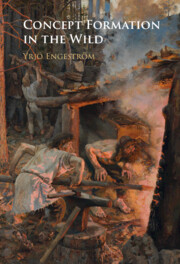Figures
2.1First lessons for the study of concept formation in the wild
3.1Sannino’s (2020, p. 169) model of transformative agency by double stimulation
3.4Guiding ideas for the study of concept formation in the wild
4.2The old organization chart of the surgical operating unit
4.3The new organization chart of the surgical operating unit
4.4Notational template for constructing homelessness pathways for possibilization
4.5A Change Laboratory participant’s representation of Mikko’s homelessness pathway
4.6A Change Laboratory participant’s representation of Tomi’s homelessness pathway
4.7Representation of homelessness pathways produced by two formerly homeless residents of a supported housing unit
4.9Chain of distributed actions in the formation of a germ cell concept in the library
4.10The germ cell concept of knotworking in the university library
5.2Standing up from the chair as an internally contradictory germ cell of sustainable mobility
5.3Ascending from the abstract to the concrete in Anne’s case
6.5Different ways of using artifacts in the four home care visits
7.1The stepwise emergence of theoretical concepts as a result of ascending from the abstract to the concrete (Davydov, 1990)
7.2The emergence of concepts as a result of density and stabilization of cognitive trails (Cussins, 1992, p. 683)
7.3Concept formation in the wild as movement along two dimensions
7.4Developmental contradictions in the activity system of the board of the food cooperative
7.5Developmental contradictions in the activity systems of the university library
7.6Mobility-related developmental contradictions in the activity systems of the home care
7.7Movement toward the concept of expansive degrowth in the food cooperative
7.8Movement toward the concept of knotworking in the library
7.9The movement of the concept of sustainable mobility in home care
8.2Second set of key differences between the PHF and the FHF
8.3The contradiction between substances and home as driving force for the concept of Housing First (Sannino, Engeström & Kärki, 2023, p. 48)
8.4The FHF concept as a solution to the contradiction (Sannino, Engeström & Kärki, 2023, p. 49)
8.6The contradiction between permanence and mobility in homelessness work (Sannino, Engeström, & Kärki, 2023, p. 52)
8.7Transformation of Nopsajalka’s operating model in Jyväskylä (Sannino, Engeström & Kärki, 2023, p. 22)
8.8The Housing First 2.0 concept as a solution to the contradiction (Sannino, Engeström, & Kärki, 2023, p. 53)
9.1Evolution and design in four cases of formation of germ cell concepts

